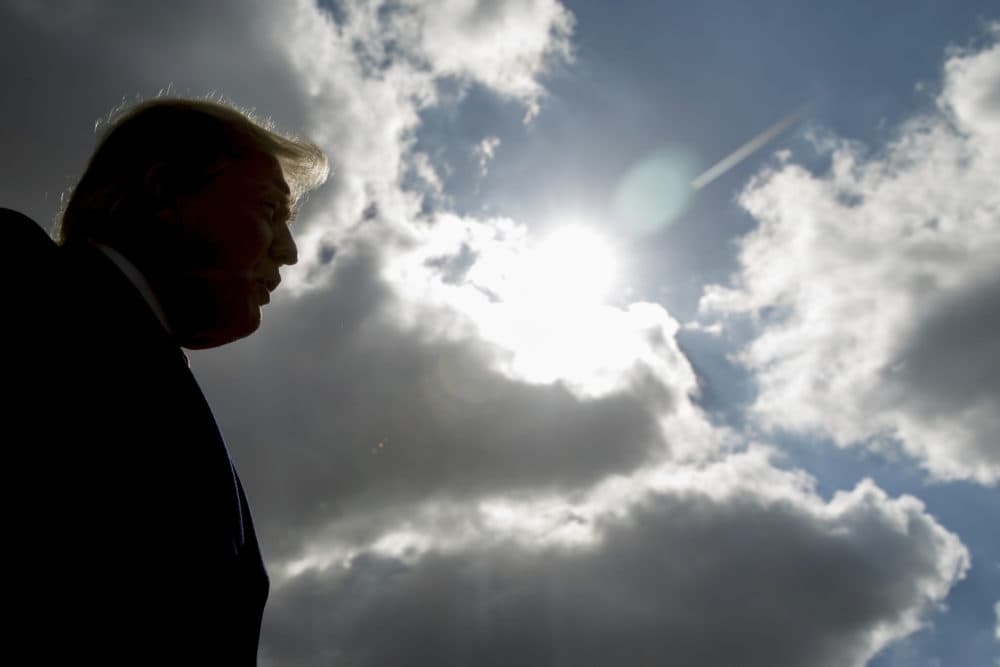Advertisement
Covering Climate
The Trump Administration Is 'Silencing Science,' Environmental Law Expert Says
Resume
This conversation is part I of our three-part series called "Silencing Science."
The Trump administration has rolled back at least 95 environmental regulations since taking office.
The wide-ranging policy shifts have targeted water, land, air and public health protections — and have threatened the science behind these protocols.
“This is beyond [George] Orwell,” says Michael Gerrard, director of the Sabin Center for Climate Change Law at Columbia University.
Along with the Climate Science Legal Defense Fund, the Sabin Center has been tracking the erosion of climate science under Trump using their “Silencing Science Tracker.”
The concept for the tracker began quickly after Trump’s inauguration as a mechanism to hold the government accountable for its actions, Gerrard says. The tracker now has more than 380 entries.
For example, on Dec. 24, 2019, the National Library of Medicine’s Toxmap website — an easy-access federal database dedicated to mapping sources of pollution across the U.S. and Canada — was taken down.
“The data are still available in obscure places that you have to hunt for,” he says. “But the general public no longer has easy access to this information about the sources of pollution in the communities where they live or might want to move.”
Just a glance at the immense “Silencing Science Tracker” proves Trump’s government isn’t interested in “expertise that might lead to conclusions that they dislike,” Gerrard says.
The government has diminished some scientific committees and replaced them with industry representatives, which has caused “an enormous amount of distress” in the scientific community, he says. People who have dedicated their lives to environmental research and education are being “squelched,” leaving some — especially young scientists he works with at Columbia — to pursue opportunities outside of the federal government.
And increasingly, scientists are being told not to write certain articles or appear at certain events, he says. For example, last year, U.S. National Park Service’s principal climate change scientist received a cease-and-desist letter after he testified about the adverse impacts of human-caused climate change in national parks.
These tactics tend to be effective in muzzling scientists, he says.
Trump’s aim to boost businesses and the economy through deregulation may apply to the coal industry, he says. But that may not be the case for businesses who would be interrupted — or destroyed — by extreme weather events such as wildfires, flooding or hurricanes, he says.
“It's only a very small slice of the economy that is helped by this deregulation,” he says. “Much larger portions of it are hurt.”
Supporters of Trump’s rollbacks believe federal scientific agencies shouldn’t be funded by taxpayer dollars. But Gerrard says if private sector dollars pay for the research and industries don’t publicize the negative impacts of their findings, then the public is left in the dark or misled by bias data.
“It's much more economical to society to have independent, objective science,” he says.
Science is flourishing in other areas of the government, such as NASA’s research and development — likely because NASA doesn’t threaten “reducing profits in certain sectors of the economy,” he says. But he says it’s clear climate science and environmental protection take priority on Trump’s chopping block.
And that reflects poorly on the U.S. — and also puts the nation in danger of falling behind in innovative climate technology and from preparing for catastrophic climate events that “we know are coming,” he says.
Environmental scientists are “all being thrown under the bus,” he says. “And the country will be much poorer for it.”
Editor's Note: The National Library of Medicine reached out to us to say" the decision to retire ToxMap was made by NLM and not the Administration. As the NLM implements its current strategic plan, it has had to make some difficult organizational changes that have resulted in some resources and programs being integrated into other NLM resources, made accessible on partner sites, or discontinued. These changes are intended to provide greater alignment of resources to fulfill NLM’s mission. The sunset of ToxMap was announced in early summer 2019 to give users sufficient time to transition to other sources. NLM has taken great care to ensure that no data become unavailable as we reorganize our toxicology and other resources. Some data have been archived and made available via FTP.
In the case of ToxMap, underlying data remains available through their original sources, and GIS application users can overlay the data in their own GIS applications. We are pleased that some users preferred the NLM interface, but ToxMap is not unique as a GIS visualization application. EPA, for example, offers and continues to improve such tools. "
Selected TOXMAP data can be accessed from the following sites and this information is also available on the ToxNet redirection site:
- U.S. EPA Toxics Release Program (TRI)
- U.S. EPA Superfund Program
- U.S. EPA Facilities Registry System (FRS)
- U.S. EPA Clean Air Markets Program
- U.S. EPA Geospatial Applications
- U.S. NIH NCI Surveillance, Epidemiology, and End Results Program (SEER)
- Government of Canada National Pollutant Release Inventory (NPRI)
- U.S. Census Bureau
- U.S. Nuclear Regulatory Commission (NRC)
Cassady Rosenblum produced and edited this interview for broadcast with Kathleen McKenna. Serena McMahon adapted it for the web.
This segment aired on February 3, 2020.

